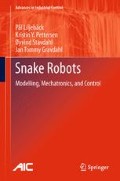Abstract
In this chapter, we return to the problem of enabling a snake robot to track a planar path. Previously in this book, we proposed a straight line path following controller and employed a Poincaré map to prove that the state variables of the snake robot, except for the position along the path, trace out a locally exponentially stable periodic orbit during motion along the desired path. The drawback of the analysis based on the Poincaré map, however, is that we are only able to infer conclusions regarding the local stability properties in the vicinity of the desired path. Moreover, since the analysis is based on simulating the model of the snake robot, the stability proof is only valid for the given choice of numerical controller parameters.
In order to elude the shortcomings of the previous analysis, this chapter extends the path following controller by employing the simplified model of the snake robot. Using cascaded systems theory, we prove that the modified path following controller \(\mathcal{K}\)-exponentially stabilises the snake robot to any desired straight path. In particular, under the assumption that the forward velocity of the snake robot is non-zero and positive, we show that the model of the snake robot and the controller can be written as a cascaded system where the body shape changes affect the global orientation of the robot, which subsequently affects the cross-track error between the robot and the desired path. The \(\mathcal{K}\)-exponential stability of the cascaded system guarantees that the cross-track error and the heading of the snake robot with respect to the direction of the path converge to zero. The performance of the path following controller is investigated through simulations and through experiments with the snake robot Wheeko. The simulations and the experimental results show that the proposed controller successfully steers the snake robot towards and along the desired straight path.
This chapter also considers path following of more general paths. In particular, we propose a waypoint guidance strategy which provably steers a snake robot along a path defined by waypoints interconnected by straight lines. In addition, we describe how the straight line path following controller can be extended to path following of general curved paths.
Access this chapter
Tax calculation will be finalised at checkout
Purchases are for personal use only
References
Børhaug, E.: Nonlinear control and synchronization of mechanical systems. Ph.D. thesis, Norwegian University of Science and Technology (2008)
Do, K.D., Pan, J.: Global tracking control of underactuated ships with off-diagonal terms. In: IEEE Conf. Decision and Control, vol. 2, pp. 1250–1255 (2003)
Egeland, O., Gravdahl, J.T.: Modeling and Simulation for Automatic Control. Marine Cybernetics, Trondheim (2002)
Fossen, T.I.: Marine Control Systems: Guidance, Navigation and Control of Ships, Rigs and Underwater Vehicles. Marine Cybernetics, Trondheim (2002)
Fredriksen, E., Pettersen, K.Y.: Global κ-exponential way-point maneuvering of ships: theory and experiments. Automatica 42, 677–687 (2006)
Khalil, H.K.: Nonlinear Systems, 3rd edn. Prentice Hall, New York (2002)
Lefeber, E.: Tracking control of nonlinear mechanical systems. Ph.D. thesis, Department of Applied Mathematics, University of Twente, The Netherlands (2000)
Panteley, E., Loria, A.: On global uniform asymptotic stability of nonlinear time-varying systems in cascade. Syst. Control Lett. 33(2), 131–138 (1998)
Panteley, E., Lefeber, E., Loria, A., Nijmeijer, H.: Exponential tracking control of a mobile car using a cascaded approach. In: Proc. IFAC Workshop on Motion Control, pp. 221–226 (1998)
Pavlov, A., Børhaug, E., Panteley, E., Pettersen, K.Y.: Straight line path following for formations of underactuated surface vessels. In: Proc. IFAC NOLCOS (2007)
Pettersen, K.Y., Lefeber, E.: Way-point tracking control of ships. In: Proc. IEEE Conf. Decision and Control, pp. 940–945 (2001)
Sørdalen, O.J., Egeland, O.: Exponential stabilization of nonholonomic chained systems. IEEE Trans. Autom. Control 40(1), 35–49 (1995)
Author information
Authors and Affiliations
Corresponding author
Rights and permissions
Copyright information
© 2013 Springer-Verlag London
About this chapter
Cite this chapter
Liljebäck, P., Pettersen, K.Y., Stavdahl, Ø., Gravdahl, J.T. (2013). Path Following Control of Snake Robots Through a Cascaded Approach. In: Snake Robots. Advances in Industrial Control. Springer, London. https://doi.org/10.1007/978-1-4471-2996-7_8
Download citation
DOI: https://doi.org/10.1007/978-1-4471-2996-7_8
Publisher Name: Springer, London
Print ISBN: 978-1-4471-2995-0
Online ISBN: 978-1-4471-2996-7
eBook Packages: EngineeringEngineering (R0)

